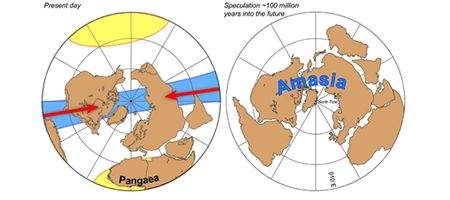Make the most of the Caribbean on your next vacation – it won’t be around for ever.

Geologists at Yale University have developed a radical new theory of the formation of continents, and predict the creation of a new supercontinent, dubbed Amasia, over the North Pole during the next 50 to 200 million years.
First to disappear, they say, will be the Caribbean and the Arctic Ocean.
The team is proposing a process called orthoversion, in which each succeeding supercontinent forms 90 degrees from the geographic center of its ancient predecessor. Under this theory, the present-day Arctic and Caribbean will vanish as North and South America fuse as they move north and eventually collide with Europe and Asia.
“After those water bodies close, we’re on our way to the next supercontinent,” says Ross N Mitchell, the Yale doctoral student who is the paper’s first author. “You’d have the Americas meeting Eurasia practically at the North Pole.”
Current theories hold that supercontinents form either 0 or 180 degrees away from the geographic center of the previous supercontinent. This indicates that the Atlantic Ocean will disappear and the next supercontinent form with a center more or less in the same spot as the last one – present-day Africa – or else that the Pacific Ocean will disappear and the next supercontinent form with a center on the opposite side of the globe.
However, Mitchell and his colleagues have arrived at a different theory, after studying the magnetism of ancient rocks.
After each historical supercontinent assembled, it underwent a series of back-and-forth rotations around a stable axis along the equator. From one supercontinent to the next, the axes were offset from each other by about 90 degrees, says the team.
“This kind of analysis gives us a way to arrange continents in both latitude and longitude, providing a better understanding in patterns of biological dispersal and the dynamics of Earth’s deep interior,” said Yale doctoral student Taylor M. Kilian, the study’s second author.
Under the orthoversion model, either Asia or North America would become the center of Amasia, in a spot currently occupied by the Arctic Ocean. A newly formed mountain range will stitch them together.
“Such speculations far into the future cannot be tested by waiting around 100 million years, of course,” says senior author Professor David Evans.
“But we can use the patterns gleaned from ancient supercontinents to think deeply about humanity’s current existence in time and space within the grand tectonic dance of the Earth.”






